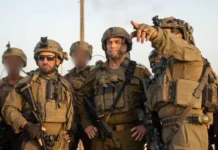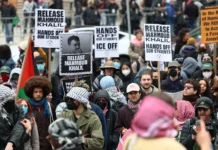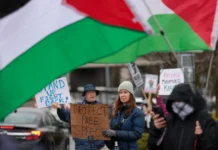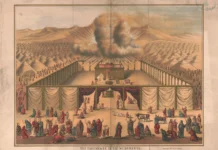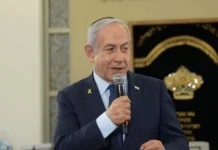Hezbollah is burning a swathe through northern Israel. The nature reserves, grazing land, fields and orchards are burning to the ground. Military bases, including several strategic assets, are incurring major damage. More than 1,000 homes have been destroyed. Businesses are bankrupt. And some 80,000 Israelis are living in hotels with no sense of when they may be able to go home.
Hezbollah has significantly increased the pace and lethality of its attacks on the Upper and Western Galilee, as well as the Golan Heights in recent weeks, and extended its attacks to the Carmel and the Jezreel Valley.
Haifa, Acre and Tiberias have all been subjected to missile, drone and rocket assaults. During Shavuot on Wednesday, Hezbollah shot more than 200 projectiles at Israel. On Thursday, more than 100 more continued and expanded the fires, destruction and mayhem.
The Israel Defense Forces claim that Hezbollah’s actions haven’t broken the mold of tit-for-tat assaults that Hezbollah and Israel have been exchanging for the past eight months. On Tuesday night, the Israeli Air Force carried out an airstrike on the Nasser Unit of Hezbollah’s southern command. The Nasser unit is a division-sized formation responsible for Hezbollah’s operations along the border with Israel.
The unit’s commander, Taleb Sami Abdullah, and three of his senior staff were killed in the raid. The IDF’s claim that Hezbollah’s massive missile, drone and rocket barrages on Wednesday and Thursday, and into Friday, are a tit-for-tat supports Hezbollah’s line that its massive aggression is a legitimate reaction to Abdullah’s assassination.
The IDF’s claim is, to be sure, self-defeating. But that’s not the main problem.
The main problem with the IDF’s assertion is that it ignores the strategic logic of Hezbollah’s operations. Hezbollah isn’t attacking in response to any specific Israeli operation. It is attacking to achieve its strategic goals. Hezbollah isn’t simply abusive; it is waging a strategic war with clear long-term and intermediate strategic objectives.
Hezbollah began shelling Israel with drones, anti-tank rockets and missiles on Oct. 8. It has maintained and slowly escalated its attacks since then. Far from reactive, Hezbollah’s moves are ends-driven. From one assault to the next, Hezbollah learns more about penetrating Israel’s defenses. Its escalatory cycle is a function of its learning curve.
Enabling Hezbollah’s control over Lebanon
What are the goals that Hezbollah uses its projectile campaign to achieve? Hezbollah’s ultimate goal is that of its Iranian overlord: Israel’s annihilation. But it has intermediate goals on the road to final victory. The first is to achieve operational control over northern Israel. Such control, Hezbollah and Iran assess, will force Israel to capitulate on the strategic battlefield. If Hezbollah’s anti-tank rockets, drones and missiles are able to cancel Israel’s ability to defend northern Israel, then Israel will be forced to capitulate on the issue of formal sovereignty at the negotiating table in order to achieve “quiet.”
The specific “deal” Hezbollah seeks involves Israel’s formal surrender of its sovereignty over Mount Dov, a vast area in the Golan Heights that controls all of northern Israel, including the Gulf of Haifa.
Hezbollah is able to advance its operations because it is protected by a series of actors both within Lebanon and in the international arena. As Lebanon affairs expert Tony Badran has argued convincingly for years, Hezbollah is Iran’s Lebanese foreign legion. It is also Lebanon itself.
Hezbollah controls all aspects of politics and security affairs in the country and much of the economy. Lebanon’s official bodies, its state institutions (including the Lebanese Armed Forces), the parliament, the Central Bank and the government are all fig leaves whose purpose is to hide this basic truth. UNIFIL, the U.N. military force mandated to keep Hezbollah away from the border with Israel, operates at Hezbollah’s pleasure. Its personnel live (and die) at Hezbollah’s pleasure. As a result, not only is the agency incapable of carrying out its mandate, but like the LAF, UNIFIL’s continued presence along the border shields Hezbollah forces and assets from the IDF.
Under Hezbollah’s control, Lebanon is not an actual country. It is Iran’s forward military base against Israel that happens to have 5.5 million residents. The job of the residents is to deny that they live in an Iranian missile base.
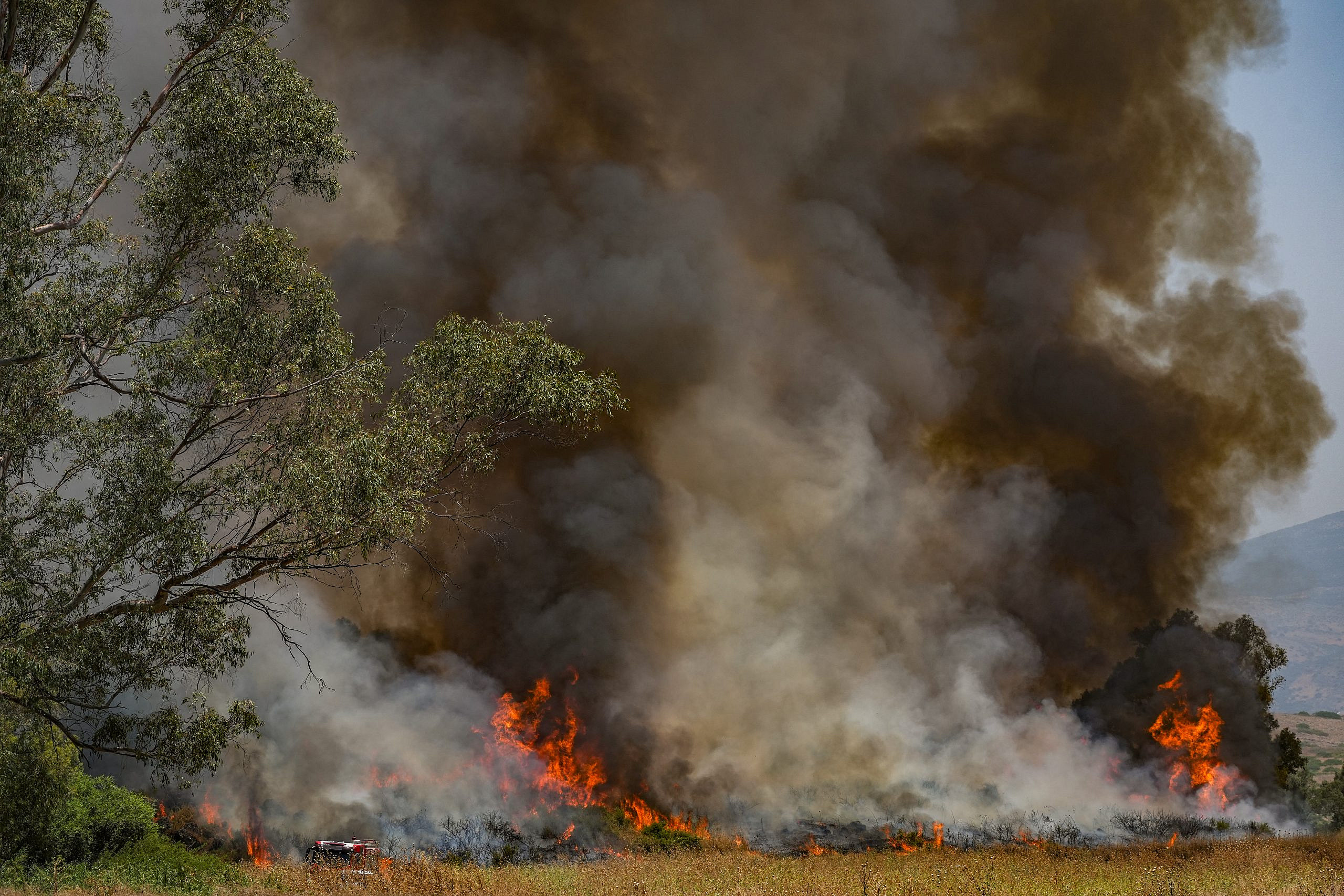
Like the United States and the European Union, the United Nations is perfectly capable of recognizing the basic truth. But it obstinately refuses to do so. Instead, it enables Hezbollah’s continued control by joining the Lebanese in maintaining the fiction that Lebanon is still a country with state institutions that operate independently of Hezbollah, is in a position to oppose Hezbollah’s actions, and therefore, worthy of U.S. and international monetary and military support. That position allows them to play-act at diplomacy and mediate Israeli surrender deals to Hezbollah’s genocidal aggression while avoiding direct confrontations with either Hezbollah or Iran themselves.
The most prominent policymaker engaged in make-believe diplomacy on behalf of Hezbollah’s strategic goals is President Joe Biden’s envoy Amos Hochstein. Hochstein secured Hezbollah’s first major strategic victory over Israel in October 2022. The maritime border “agreement” that he forced Israel’s caretaker Lapid government to accept on the eve of the November 2022 elections required Israel to surrender its territorial and economic waters, as well as its rights to an unexplored natural-gas deposit to Hezbollah-controlled Lebanon. All Hezbollah needed to do to convince Hochstein and Biden to force Israel’s capitulation was fire a series of missiles at Israel’s Leviathan gas platform.
In the face of Hezbollah’s assaults and the protection it enjoys from supporters both within Lebanon and on the world stage, Israel is left with a dilemma. Permitting Hezbollah to achieve its goals would be national suicide. But in order to block Hezbollah from achieving its goals, Israel will once again need to fight a major war against another enemy protected by the international system.
There is also the military challenge. For the past generation, successive IDF General Staffs have embraced the notion that the era of big conventional wars is over. Based on this false, but popular assessment, for 20 years, the General Staff slashed Israel’s ground forces and placed most of Israel’s resources in the air force and other technology-driven units. These forces were directed not towards developing plans to defeat Hamas and Hezbollah, but towards attacking Iran’s nuclear installations, preferably as part of a U.S.-led force. The notion that Israel could gut its strategic independence in exchange for U.S. strategic guarantees dominated Israel’s national security discourse.
However, since Oct. 7, Israel has found itself in a major conventional war on seven fronts: Gaza, Lebanon, Judea and Samaria, the Red Sea, Iran and Iraq/Syria.
While Israel prepared for the war it wanted to fight—a low-cost, high-tech war fought mainly from air-conditioned operations centers by remote control—its enemies prepared for the war they wanted to fight. Namely, that is their war to eliminate Israel. Israel trained hackers, and Hamas and Hezbollah trained jihadist terror armies of murderers, rapists and squads to launch missiles, drones and rockets.
Fighting these armies with Israel’s high-tech force is proving to be extremely difficult. Israel’s assumption of U.S. support has also taken a major hit. To be sure, Washington is willing to support Israel’s efforts to defend itself from aggression along the seven fronts manned by Iran and its proxies. But it opposes Israeli offensive action and has worked actively to undermine Israel’s ability to carry out prolonged offensive operations. Among other things, the United States refuses to share satellite and other intelligence related to offensive objectives, and is placing embargoes or slowwalking the transfer of offensive munitions for Israel’s ground and air forces.
End Hezbollah’s reign of terror
Given the strategic imperative of defeating Hezbollah and preventing it from achieving operational or strategic control over northern Israel, and in light of Israel’s diplomatic weakness relative to Hezbollah (and Hamas) and its operational weaknesses, the question is how should Israel proceed?
The answer begins with the strategic imperative. Israel must end Hezbollah’s reign of terror over northern Israel. It must degrade Hezbollah’s military capacity to the point that Hezbollah is no longer able to strike Israel at will. To achieve this goal, Israel needs to take control over the Lebanese side of the border, destroy Hezbollah’s forces south of the Litani River and then remain in place in Southern Lebanon for the foreseeable future.
Such a goal is, of course, easy to declare. But it is far more difficult to achieve. Realistically, to accomplish this objective, Israel needs to vastly increase the size of its standing and reserve forces, and possess the military-industrial capacity to arm its forces independently. Israel is already working to achieve both of these objectives. However, industrial independence and the enlargement of military forces take time to achieve. And time is of the essence. The residents of the north now scattered in hotels throughout the country cannot be expected to wait years to return to their homes.
Then-prime minister Ehud Barak’s decision to surrender the security zone in Southern Lebanon to Hezbollah in May 2000 is the reason that the terror organization was able to build its forces to the point where it poses an existential threat to Israel’s survival. By committing itself to reversing his move, Jerusalem will place itself on the road to victory. The government will steel the public for the road ahead, and provide the General Staff and lower echelons of the IDF with the required guidance for developing and carrying out tactical missions that will advance Israel’s ultimate goal.
If Israel invades Lebanon with a corps-sized force, it will unify the U.S.-led international community to rally against it. But if it moves slowly, with discrete battles against specific targets, Israel can remain below the radar screens of hostile Western capitals and global institutions. On the surface, Israel can present its operations as mere responses to Hezbollah’s strikes. But just as Hezbollah uses every missile assault as a means to probe and learn how to penetrate Israel’s defenses to advance its strategic goal, so too, by attaching every action to the strategic objective of restoring the security zone in Southern Lebanon, Israel’s operations will be paving stones on the road to strategic victory.
Each move will make the north safer. And each move will undermine Hezbollah’s goals. By acting slowly and deliberately, Israel can learn as it goes, adapting its operations to the conditions that it discovers on the ground, expanding them when political realities allow and constraining them when those realities are more daunting.
To date, most of Israel’s actions in Lebanon have involved killing Hezbollah military commanders like Abdullah. Yet as the Alma Research and Education Center, which specializes in Hezbollah’s operations and capabilities, noted in an analysis of the operation and others like it: “Everyone has a successor.”
“An attempt to remove top officials can only be a supporting endeavor. It is vital and right, but ultimately it is a tactical endeavor with no strategic significance.”
A slowly escalating operation in Lebanon directed towards the strategic aim of ending Hezbollah’s assault on northern Israel and securing Israel’s sovereignty will enable Israel to gradually escalate its operations as its forces are readied and military-industrial independence expanded. It will provide a means to avoid the worst of the international calumny that Israel will surely suffer in a mass invasion while moving Israel steadily towards a strategic goal capable of securing Israel’s vital interests—and survival.




